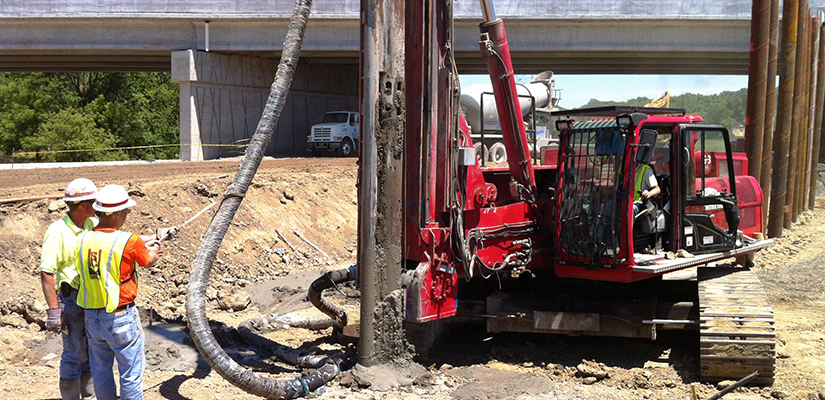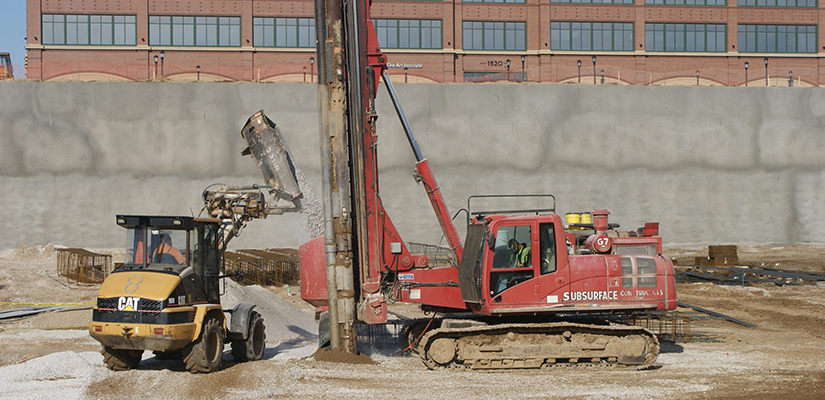Ground improvement techniques come in many forms that match the characteristics of the soil they’re designed to improve and the structures that must be supported.
Inserting vertical columns into soil to improve its ability to support foundations is one such form, and even that comes with variants: Stone columns (also called aggregate piers) are the more commonly-used ground improvement solution, while grouted columns —which fall under the broad category of “rigid inclusions”— are the preferred choice when soil is exceptionally weak.
Below, we discuss these soil improvement methods, including describing their installation and explaining why they’re chosen.
Grouted column ground improvement
Grouted columns are recommended for very soft soils, such as peats and organic silts. These soil types are exceptionally weak and lack the shear strength needed to support stone columns. Installing stone columns in these weak soils would almost certainly lead to excessive settlement: With only very soft soil confining the stone, the columns would balloon outward into the adjacent soil.
At Subsurface Constructors, we install grouted columns using vibrating probes that displace soil as they’re inserted into the ground (hence the name for this type of ground improvement—vibro concrete columns, or VCCs). Then, grout (mixed on-site or trucked in) is pumped via a tremie pipe connected to the probe. A small “bulb” of grout is created at the bottom of the shaft, and then the probe slowly rises as more grout is poured, filling the vertical void.

Like most concrete mixes, VCCs fully cure after around 28 days. However, they set up enough in the hours after their installation that subsequent foundation work can begin the next day.
It’s important to note that load transfer platforms (LTPs) are often recommended as an intermediate layer between grouted columns and structural footings, or whatever type of structure they may be supporting (tanks, earth embankments, etc.). Without LTPs, the rigid-on-rigid contact between grouted columns and footings increases the risk of overstressing the footing. LTPs usually consist of layers of compacted stone interlayered with geogrid or geotextile, and could be anywhere from six inches to six feet thick. They more evenly distribute the footing load across a group of grouted columns.
Stone columns (aggregate piers)
Stone columns or aggregate piers are most often used to reinforce soft, cohesive soils, and can typically provide bearing pressures in the range of 4,000 to 6,000 psf. However, there needs to be some strength to the existing soils to make stone columns work.

At Subsurface Constructors, we install stone columns in much the same way as we do VCCs. A vibrating probe displaces soil outward as it bores down to the desired depth, and stone or other granular material is delivered to the bottom of the hole in segments called “lifts.” Depending on the stability of the existing soil, the stone can be dumped from the ground surface (top-feed), or tremied to the bottom of the hole (bottom-feed). After each lift is delivered, the vibrating probe compacts the stone with vibration and down-pressure. The process is repeated until the hole is filled with a dense column of aggregate.
Because we use vibratory probes during the installation of aggregate piers, we use the term “vibro stone columns” or VSCs.
Adding value for you
All things held equal, stone columns are typically the cheaper of these ground improvement techniques. But soil types vary dramatically, so choosing between the two is more a matter of feasibility than of cost. Geotechnical contractors should use soil data gathered on-site to recommend a solution that balances what’s best for the bottom line and what ensures a structure will stand on solid ground.
At Subsurface Constructors, we have broad experience with the various soil types we encounter across the U.S. Our geotechnical engineers are committed to recommending the highest quality solution that delivers the best value to the job. Close collaboration between our in-house design and construction teams ensure the ground improvement methods we employ will give the rest of your project a firm footing.
Dig deeper for more information about how we’ve completed VCC and VSC ground improvement by reading our case studies. Our guide to aggregate pier ground improvement is another resource you may find useful. If you have questions or want to speak with a geotechnical engineer about your next project, contact us now.


